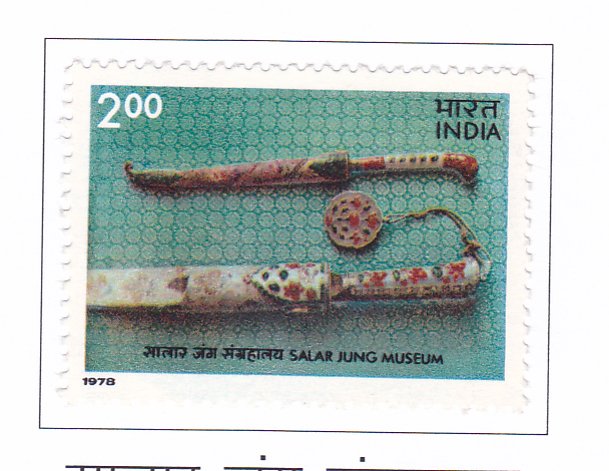Salar Jung Museum

Technical Data
| Stamp Set | Treasures from Indian Museums |
|---|---|
| Date of Issue | July 27, 1978 |
| Denomination | Rs. 2 |
| Quantity | 2,000,000 |
| Perforation | comb 13½ x 13 |
| Printer | Security Printing Press, Nashik |
| Watermark | No Watermark |
| Colors | Multicolor |
| Catalog Codes |
Michel IN 766 Stamp Number IN 803 Yvert et Tellier IN 562 Stanley Gibbons IN 893 |
| Themes | Museums | Weapons |
Museums are repositories of the cultural, literary, and artistic heritage of a people, and they also provide significant opportunities for education and national integration. The museum movement in India began with the establishment of the Indian Museum in Calcutta in 1814 by the Asiatic Society of Bengal. Following the enactment of the Ancient Monuments Preservation Act in 1904, several archaeological museums were established. Over the years, many more museums have been created, covering various disciplines such as art, archaeology, science, and technology. Today, India boasts over 360 museums.
In choosing subjects for a series of postage stamps on the Museums of India, the Posts and Telegraphs Department aimed to represent the extensive span of Indian history and the diverse artistic expressions from different regions of the country.
The 200 paise stamp, for example, features two jeweled arms housed in the Salar Jung Museum in Hyderabad. The dagger and knife are traditionally believed to have belonged to Mughal Emperor Jehangir and his consort Nur Jahan, respectively. Although there are no inscriptions to verify their ownership, the arrangement of precious stones and the exquisite craftsmanship suggest they are products of Mughal artisanship from the 17th century. Both the dagger and knife have handles made of white jade adorned with ruby flowers and emerald leaves. The dagger includes a pendant in the shape of a flower, also made of white jade and decorated with floral motifs crafted from rubies and emeralds.
